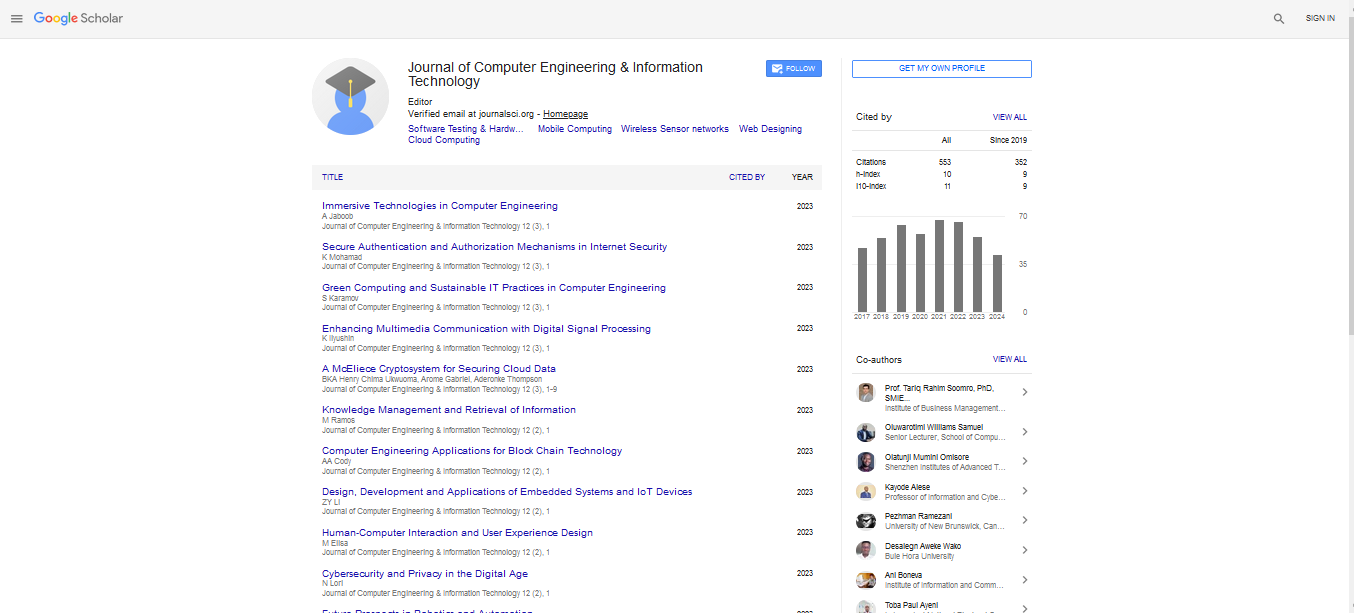Opinion Article, J Comput Eng Inf Technol Vol: 13 Issue: 5
Evolving Threats: An In-Depth Analysis of Modern Cyber Attack Strategies
Ali Ozkan*
1Department of Cyber Security, Cranfield University, Cranfield, UK
*Corresponding Author: Ali Ozkan,
Department of Cyber Security, Cranfield
University, Cranfield, UK
E-mail: ali.ozkan@cranfield.ac.uk
Received date: 13 August, 2024, Manuscript No. JCEIT-24-146802;
Editor assigned date: 16 August, 2024, Pre QC No. JCEIT-24-146802 (PQ);
Reviewed date: 30 August, 2024, QC No. JCEIT-24-146802;
Revised date: 06 September, 2024, Manuscript No. JCEIT-24-146802 (R);
Published date: 13 September, 2024, DOI: 10.4172/2324-9307.1000307
Citation: Ozkan A (2024) Evolving Threats: An In-Depth Analysis of Modern Cyber Attack Strategies. J Comput Eng Inf Technol 13:5.
Description
In the digital age, the landscape of cyber threats is continuously evolving, presenting new challenges for individuals, organizations and governments alike. As technology advances, so do the strategies employed by malicious actors. This analysis discuss into the modern cyber-attack strategies, exploring how they have evolved, their impact and strategies to counteract them. Initially, cyber threats were relatively simple, often involving straightforward attacks like viruses and worms designed to disrupt systems or steal data. These early threats primarily targeted individual systems, exploiting basic vulnerabilities. As technology advanced, so did attack strategies. The emergence of targeted attacks marked a significant shift. Attackers began focusing on specific individuals or organizations, employing techniques like spear-phishing and social engineering. These methods involve personalized attacks designed to exploit specific weaknesses in the target's defenses, often including information gathered through reconnaissance.
In recent years, cyber-attacks have become increasingly sophisticated and automated. Attackers now use advanced tools and techniques, including artificial intelligence and machine learning, to enhance their capabilities. Automated attack scripts can probe vulnerabilities at scale, identifying and exploiting weaknesses faster than ever before. Phishing remains a prevalent cyber-attack strategy, involving deceptive emails or messages that trick recipients into revealing sensitive information. Spear-phishing, a more targeted variant, uses personalized tactics to deceive specific individuals, often leading to significant data breaches or financial losses. These attacks exploit human psychology, including social engineering to achieve their objectives. Ransomware attacks have gained prominence in recent years, with attackers encrypting a victim's data and demanding payment for the decryption key. The increasing sophistication of ransomware, including the use of double extortion tactics (threatening to release stolen data if the ransom isn't paid), has made these attacks more dangerous.
High-profile ransomware incidents have highlighted the severe impact on organizations, leading to operational disruptions and financial losses. Advanced Persistent Threats (APTs) involve prolonged and targeted attacks by well-resourced adversaries, often nation-states or organized criminal groups. These attacks are characterized by their stealth and persistence, aiming to gain and maintain access to a target's network for extended periods. APTs employ various techniques, including zero-day exploits and sophisticated malware, to achieve their objectives. The primary goal is often espionage or intellectual property theft, with attackers working covertly to avoid detection. Denial-of-Service (DoS) and Distributed Denial-of-Service (DDoS) attacks aim to overwhelm a target's resources, rendering services unavailable to legitimate users. While early DoS attacks were relatively simple, modern DDoS attacks are more complex and involve large-scale botnets to generate massive volumes of traffic. These attacks can disrupt business operations, damage reputations and result in financial losses.
Supply chain attacks target organizations by compromising a thirdparty vendor or service provider. By infiltrating the supply chain, attackers can gain access to multiple organizations simultaneously. The solar winds attack is a notable example, where attackers inserted malicious code into a widely used software update, impacting numerous high-profile organizations. Man-in-the-Middle (MitM) Attacks MitM attacks involve intercepting and potentially altering communications between two parties without their knowledge. Modern MitM attacks include techniques like session hijacking and packet sniffing to gain unauthorized access to sensitive information. These attacks can undermine data integrity and confidentiality, leading to significant security breaches. The proliferation of Internet of Things (IoT) devices has introduced new attack vectors. Many IoT devices lack robust security measures, making them vulnerable to exploitation. Attackers can exploit vulnerabilities in IoT devices to gain unauthorized access to networks, launch DDoS attacks, or collect sensitive data. Crypto jacking involves unauthorized use of a victim's computing resources to mine cryptocurrency. Attackers often employ malware to hijack system resources, causing performance degradation and increased operational costs.
Crypto jacking has become a growing concern as cryptocurrency mining gains popularity. Cyber-attacks can result in significant financial losses, including ransom payments, legal fees and costs associated with remediation and recovery. The financial impact can be especially severe for Small And Medium-Sized Enterprises (SMEs), which may lack the resources to manage and recover from attacks effectively. As cyber threats continue to evolve, staying informed about the latest attack strategies and implementing robust defenses is essential for safeguarding digital assets. By understanding modern cyber-attack strategies and adopting proactive measures, individuals and organizations can better protect themselves against the growing array of cyber threats. The dynamic nature of cyber threats requires ongoing vigilance, adaptability and collaboration to effectively manage and alleviate risks in an ever-changing digital landscape.
 Spanish
Spanish  Chinese
Chinese  Russian
Russian  German
German  French
French  Japanese
Japanese  Portuguese
Portuguese  Hindi
Hindi 